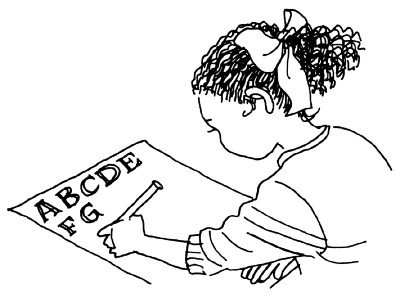9 Important First Steps to Learn Writing

Do you find it hard to teach your child how to write?
Did you know there are other things you should teach first before simply giving your child a pen an a paper
Here are 9 important first steps when teaching your child how to write:
1. Practice using games.
First, you should practice his/her fine motor skills using various games in the environment. For example: using play dough, squeezing sponge/fabric/paper, playing with sand, beading, moving a peanut using spoon/hand, colouring using fingers, or clipping something using a hanging clip.
2. Use crayon instead of pencil.
Crayon is easier to grab because it is bigger than a pencil and it’s easier to write with.
Try teaching the child to colour using crayon. If he/she has mastered it, then teach him/her to use pencil, marker, then brush and paint.
3. Give them a big-sized pencil.
Let the child doodle using a big pencil, then gradually reducing the size to standard.
4. Teach the child to hold the pencil properly.
Here is the right way to hold a pencil: The pencil should be held with three fingers, such as thumb, index finger, and middle finger. The grip should be close to the pointy end of the pencil, approximately 1-3 cm.
Let the pencil touch your palm, and ask the child to press/push it down to the centre of your palm.
5. Use rubber bands.
If the child’s grip is not strong enough, we can use rubber band to hold the pencil to the child’s wrist.
6. Use a big media to start with.
You should let the child feel free when learning how to write by giving them a bigger media. For example: Writing on a black board using marker or chalk, writing on drawing papers/manila/newspaper, or other surfaces. When the child is better at writing, we can lessen the size of the media.
7. Use writings in books as an example.
Teach the kid how to see different kinds of writing in books and anything else, then ask the child to imitate and write those writings.
8. Give frequent practice time at home.
Initially, we can practice writing words, then sentences, paragraphs, and asking them to write about their daily activities and their favourite things.
9. Use positive encouragement.
When the child do something wrong while writing, don’t tell him/her that it is “wrong” and erasing it, but use positive encouragement, such as “something is missing, what is it?” “let’s make smaller writings”, “where’s the b?”, do decrease the amount of pressure to the child.
 Did you find the tips above helpful?
Did you find the tips above helpful?
We have created a PDF version of the tips above which you can print or share to friends. It’s available in two languages, English and Bahasa Indonesia.
Simply use the sign-up form below to access the PDF sheet:
Similar articles
Kelekatan Anak Dan Sifat Pemalunya
You're on Brain Optimax's Learning SiteGo to Brain Optimax's Main Site →Pada usia lebih dari 24 bulan, anak mulai memiliki ketertarikan untuk berinteraksi dengan orang selain anggota keluarga. Perilaku yang terlihat bisa berupa menyapa atau memperhatikan orang asing....
4 Essential Tips to Staying Brain Fit During the Holiday Season
The holiday season is an ideal time for your child to rest and recharge. If your child has been yearning for a break from the stress and routine of the hectic academic school term – he now has a “neuro-scientific” excuse for it. …
4 Tips to Enhance the Love of Reading
You're on Brain Optimax's Learning Site Go to Brain Optimax's Main Site → Reading is very important in our school-age children’s lives. Even though it is involved in every subject, many children struggle to love it, some even hates the activity. How to get our...






0 Comments